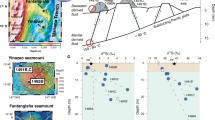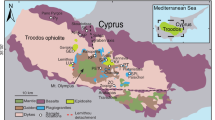Abstract
The Ordovician volcano-sedimentary succession of Erquy (northern Brittany) is made of immature sediments thermally metamorphosed at the contact of intruding basic sills. Pillow lavas constitute the upper part of the sequence. The trace element geochemistry of sills and pillow lavas suggests that they were derived from a tholeiitic source located beneath a passive margin. This volcanic sequence was metamorphosed under low to moderate greenschist facies conditions. In this study the direction and amplitude of chemical and isotopic fluxes in the basalt-sediment-water system were established and the oxygen and hydrogen isotope compositions of the aqueous fluid that reacted with the volcanic rocks were characterized. Cationic thermometry on chlorites and isotopic thermometry on plagioclase-chlorite pairs indicate closure metamorphic temperatures in the range 200–250°C for the basaltic sills. Stable isotope compositions of iron-rich chlorites (δ18O-5.5‰; δD from-60 to-50‰) and plagioclases (δ18O from +9 to +10‰) reveal that the source of the fluid was certainly seawater. The δ18O variations within the sills are strongly correlated with the rate of progress of the main metamorphic reaction:clinopyroxene+plagioclase+ilmenite → chlorite+albite+epidote+quartz+sphene that produced major element mobility at the scale of the volcanosedimentary sequence. Calculation of elemental fluxes by mass balance combined with oxygen isotopic compositions of basalts shows that the highest water-rock ratios (≥1) were at sill-sediment boundaries and within pillow lavas at the top of the pile. The volcanosedimentary sequence of Erquy was a net sink for Na and a source for Ca. No Mg uptake could be detected whereas the hydrothermal alteration of the sediments released Fe, Si, and K trapped by the volcanic rocks. The δ18O value of the fluid reacting with sills appears to have shifted no more than +4‰ after percolation at low temperature through immature sediments (δ18O≈12‰). The Erquy volcano-sedimentary sequence represents a marine hydrothermal system dominated by low-temperature exchange which allowed a general 18O-enrichment of the volcanic rocks and a 18O-depletion of sediments.
Similar content being viewed by others
References
Alt JC, Emmermann R (1985) Geochemistry of hydrothermally altered basalts: Deep Sea Drilling Project Hole 504B, Leg 83. Initial Rep Deep Sea Drilling Project 83: 249–262
Alt JC, Honnorez J, Laverne C, Emmermann R (1986) Hydrothermal alteration of a 1 km section through te upper oceanic crust, Deep Sea Drilling Project Hole 504B: mineralogy, chemistry and evolution of seawater-basalt interactions. J Geophys Res 91: 309–335
Auvray B (1969) Le volcanisme spilitique de la pointe de la Heussaye, Erquy (Côtes-du-Nord). Bull Soc Geol Mineral Bretagne: 101–118
Auvray B, Hameurt J (1971) Les caractères chimiques de la série spilitique d'Erquy (Bretagne septentrionale). Bull Soc Geol Mineral Bretagne Ser CIII: 59–76
Auvray B, Macé J, Vidal P, Van der Voo R (1980) Rb-Sr dating of Plouezec volcanics: implications for the age of red beds (“Séries Rouges”) in the northern Armorican Massif. J Geol Soc London 137: 207–210
Barriga FJAS, Kerrich R (1984) Extreme 18O-enriched volcanics and 18O-evolved marine water, aljustrel, Iberian Pyrite Belt: transition from high to low Rayleigh number convective regimes. Geochim Cosmochim Acta 48: 1021–1031
Bayliss P (1975) Nomenclature of the trioctahedral chlorites. Can Mineral 13: 178–180
Bearman G (ed) (1991) Seawater: its composition, properties and behaviour. (Oceanography series, vol 2) The Open University and Pergamon Press, Oxford
Bednarz U, Schmincke HU (1989) Mass transfer during subseafloor alteration of the upper Troodos crust (Cyprus). Contrib Mineral Petrol 102: 93–101
Berger G, Schott J, Loubet M (1987) Fundamental processes controlling the first stage of alteration of a basalt glass by seawater: an experimental study between 200 and 320°C. Earth Planet Sci Lett 84: 431–445
Bottinga Y, Javoy M (1975) oxygen isotope partitioning among the minerals in igneous and metamorphic rocks. Rev Geophys Space Phys 13: 401–418
Bowers TS, Taylor HP (1985) An intergrated chemical and stableisotope model of the origin of mid-ocean ridge hot spring systems. J Geophys Res 90: 12583–12606
Brauckmann FJ, Füchtbauer H (1983) Alterations of Cretaceous siltstones and sandstones near basalt contacts (Nûgssuaq, Greenland). Sediment Geol 35: 193–213
Bryan WB, Finger LW, Chayes F (1969) Estimating proportions in petrographic mixing equations by least-squares approximation. Science 163: 926–927
Cathelineau M, Nieva D (1985) A chlorite soild solution geothermometer: the Los Azufres (Mexico) geothermal system. Contrib Mineral Petrol 91: 235–244
Clauer N, Vidal P, Auvray B (1985) Differential behaviour of the Rb-Sr and K-Ar systems of spilitic flows and interbedded metasediments: the spilite group of Erquy (Brittany, France). Paleomagnetic implications. Contrib Mineral Petrol 89: 81–89
Clayton RN, Mayeda TK (1963) The use of bromine pentafluoride in the extraction of oxygen from oxides and silicates for isotopic analyses. Geochim Cosmochim Acta 27: 43–52
Desprairies A, Jehanno C (1983) Paragenèses minérales liées à des interactions basalte-sédiment-eau de mer (Sites 465 et 456 des Legs 65 et 60 du D.S.D.P.). Sci Geol Bull Strasbourg 36: 93–110
Deunff J, Auvray B, Cogné J, Hameurt J, Jeannette D, Vidal P (1973) Confirmation micropaléontologique de l'âge radiométrique Ordovicien Inférieur du groupe spilitique d'Erquy (Côtes-du-Nord). CR Acad Sci Paris 276: 935–937
Duff Ba (1978) Palaeomagnetic and rock magnetic studies of Lower Palaeozoic rocks on Jersey and the adjacent regions of the Armorican Massif. Ph D thesis, Univ Leeds
Einsele G, Gieskes JM, Cunay J, Moore DM, Aguayo E, Aubry M-P, Fornary D, Guerrero J, Kastner M, Kelts M, Lyle M, Matoba Y, Molina-Cruz A, Niemitz J, Rueda J, Saunders A, Schrader H, Simoneit B, Vacquier V (1980) Intrusion of basaltic sills into highly porous sediments, and resulting hydrothermal activity. Nature 283: 441–445
Fouillac AM, Javoy M (1988) Oxygen and hydrogen isotopes in the volcano-sedimentary complex of Huelva (Iberian Pyrite Belt): example of water circulation through a volcano-sedimentary sequence. Earth Planet Sci Lett 87: 473–484
Fournier-Germain B (1986) Les sédiments métallifères océaniques actuels et anciens: caractérisation, comparaisons. Thèse 3e cycle, Univ Brest
Graham CM, Viglino JA, Harmon RS (1984) Experimental study of hydrogen-isotope exchange between aluminous chlorite and water and of hydrogen diffusion in chlorite. Am Mineral 72: 566–579
Gregory RT, Taylor HPJ (1981) An oxygen isotope profile in a section of Cretaceous oceanic crust, Samail ophiolite, Oman: evidence for δ18O buffering of the oceans by deep (>5 Km) seawater-hydrothermal circulation at mid-ocean ridges. J Geophys Res 86: 2737–2755
Gresens RL (1967) Composition-volume relatioships of metasomatism. Chem Geol 2: 47–65
Guy C, Schott J, Destrigneville C, Chiappini R (1992) Low-temperature alteraction of basalt by interstitial seawater, Mururoa, French Polynesia. Geochim Cosmochim Acta 56: 4169–4189
Hart RA (1970) Chemical exchange between seawater and deep ocean basalts. Earth Planet Sci Lett 9: 269–279
Hart RA (1973) A model for chemical exchange in the basalt-seawater system of oceanic layer II. Can J Earth Sci 10: 799–816
Le Corre C, Auvray B, Ballèvre M, Robardet M (1991) Le Massif Armoricain. Sci Geol Bull 44: 31–103
Lécuyer C, Brouxel M, Albarède F (1990) Elemental fluxes during the hydrothermal alteration of the Trinity ophiolite (California) by seawater. Chem Geol 89: 87–115
Lerrier J, Maury RC, Thonon P, Girard D, Marchal M (1982) Clinopyroxene composition as a method of identification of the magmatic affinites of paleo-volcanic series. Earth Planet Sci Lett 59: 139–154
Liou JG, Ernst WG (1979) Oceanic ridge metamorphism of the East Taiwan ophiolite. Contrib Mineral Petrol 68: 335–348
Magenheim AJ, Bayhurst G, Alt J, Gieskes JM (1992) ODP Leg 137 borehole fluid chemistry in Hole 504B. Geophys Res Lett 19: 521–524
Martineau F (1976) L'origine et l'histoire de la série spilitique d'Erquy. Arguments isotopiques (Sr, Ar) et géochimie des éléments en traces. Thèse 3e cycle, Univ Rennes
Meschede M (1986) A method of discriminating between different types of mid-ocean ridge basalts and continental tholeiites with the Nb-Zr-Y diagram. Chem Geol 56: 207–218
Muehlenbachs K, Clayton RN (1976) Oxygen isotope composition of the oceanic crust and its bearing on seawater. J Geophys Res 81: 4365–4369
O'Neil JR, Taylor HP (1967) The oxygen isotope and cation exchange chemistry of feldspars. Am Mineral 52: 1414–1437
Pearce JA (1982) Trace element characteristics of lavas from destructive plate boundaries. In: Thorpe RS (ed) Andestites. Wiley, Chichester, pp 525–548
Pearce JA (1983) Role of the sub-continental lithosphere in magma genesis at active continental margins. In: Hawkesworth CJ, Norry MJ (eds) Continental basalts and mantle xenoliths. Shiva, Nantwich, pp 230–249
Rangin C, Desprairies A, Fontes JC, Jehanno C, Vernhet S (1983) Metamorphic processes in sediments in contact with young oceanic crust — East Pacific Rise, Leg 65. n: Lewis BTR, Robinson P (eds) Initial Rep Deep Sea Drilling Project 65: 375–389
Ridley WI, Perfit MR, Jonasson IR, Smith MF (1984) Hydrothermal alteration in oceanic ridge volcanics: a detailed study at the Galapagos Fossil Hydrothermal Field. Geochim Cosmochim Acta 58: 2477–2494
Savin SM, Epstein S (1970) The oxygen and hydrogen isotope geochemistry of clay minerals. Geochim Cosmochim Acta 34: 25–42
Sheppard SMF (1986) Characterization and isotopic variations in natural waters. In: Valley JW, et al (eds) Stable isotopes in high temperature geological processes. (Reviews in mineralogy 16) Mineral Soc Am, Washington DC pp 165–183
Spivack AJ, Staudigel H (1994) Low-temperature alteration of the upper oceanic crust and the alkalinity budget of seawater. Chem Geol 115: 239–247
Suzuoki T, Epstein S (1976) Hydrogen isotope fractionation between OH-bearing minerals and water. Geochim Cosmochim Acta 40: 1299–1240
Venneman TW, O'Neil JR (1993) A simple and inexpensive method of hydrogen isotope and water analyses of minerals and rocks based on zinc reagent. Chem Geol Isot Geosci 103: 227–234
Vidal P (1980) L'évolution polyorogénique du Massif Armoricain: apport de la géochronologie et de la géochimie isotopique du strontium. Mem Soc Geol Mineral Bretagne 21
Vidal P, Auvray B, Cogné J, Hameurt J, Jeannette D (1971) Données géochronologiques sur la série spilitique d'Erquy: problèmes nouveaux à propos du Brìovérien de Bretagne septentrionale. CR Acad Sci Paris 273: 132–135
Von Damm KL (1990) Seafloor hydrothermal activity: black smoker chemistry and chimneys. Annu Rev Earth Planet Sci 18: 173–204
Zheng Y-F (1993a) Calculation of oxygen isotope fractionation in anhydrous silicate minerals. Geochim Cosmochim Acta 57: 1079–1091
Zheng Y-F (1993b) Calculation of oxygen isotope fractionation in hydroxyl-bearing silicates. Earth Planet Sci Lett 120: 247–263
Author information
Authors and Affiliations
Rights and permissions
About this article
Cite this article
Lécuyer, C., Grandjean, P. & Martineau, F. Seawater-sediment-basalt interactions: stable isotope (H, O) and elemental fluxes within the Ordovician volcano-sedimentary sequence of Erquy (Brittany, France). Contr. Mineral. and Petrol. 120, 249–264 (1995). https://doi.org/10.1007/BF00306506
Received:
Accepted:
Issue Date:
DOI: https://doi.org/10.1007/BF00306506




